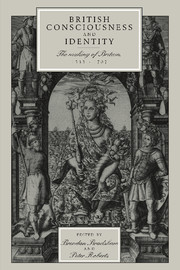Book contents
- Frontmatter
- Contents
- Notes on the contributors
- Preface
- Introduction
- 1 Tudor Wales, national identity and the British inheritance
- 2 The English Reformation and identity formation in Ireland and Wales
- 3 Faith, culture and sovereignty: Irish nationality and its development, 1558–1625
- 4 From English to British literature: John Lyly's Euphues and Edmund Spenser's The Faerie Queen
- 5 The British problem in three tracts on Ireland by Spenser, Bacon and Milton
- 6 James Ussher and the creation of an Irish protestant identity
- 7 Seventeenth-century Wales: definition and identity
- 8 Scottish identity in the seventeenth century
- 9 The Gaidhealtachd and the emergence of the Scottish Highlands
- 10 ‘No remedy more proper’: Anglo-Irish unionism before 1707
- 11 Protestantism, constitutionalism and British identity under the later Stuarts
- Index
8 - Scottish identity in the seventeenth century
Published online by Cambridge University Press: 15 March 2010
- Frontmatter
- Contents
- Notes on the contributors
- Preface
- Introduction
- 1 Tudor Wales, national identity and the British inheritance
- 2 The English Reformation and identity formation in Ireland and Wales
- 3 Faith, culture and sovereignty: Irish nationality and its development, 1558–1625
- 4 From English to British literature: John Lyly's Euphues and Edmund Spenser's The Faerie Queen
- 5 The British problem in three tracts on Ireland by Spenser, Bacon and Milton
- 6 James Ussher and the creation of an Irish protestant identity
- 7 Seventeenth-century Wales: definition and identity
- 8 Scottish identity in the seventeenth century
- 9 The Gaidhealtachd and the emergence of the Scottish Highlands
- 10 ‘No remedy more proper’: Anglo-Irish unionism before 1707
- 11 Protestantism, constitutionalism and British identity under the later Stuarts
- Index
Summary
The seventeenth century marks a crucial watershed in the long redrawing of the Scottish identity between the Reformation and the Enlightenment. During that 200 year period, from c. 1560 to c. 1760, the fundamental features of what had been the medieval Scottish identity were given new shape by the changing relationship with England that led to Scotland being assimilated into Great Britain in 1707 and by the process of creating a protestant community. These two factors, statehood and religion, are at the core of all nation-state formation in the early modern period, and each played a considerable part in the forging of national identity. Until the mid sixteenth century, the Scots were Roman Catholic and were loyal to their own Stewart kings who ruled over what was an emerging nation-state. By the latter half of the eighteenth century, the Scots were overwhelmingly protestant, being predominantly Calvinist presbyterians, while their loyalty was now divided between an historic Scottish nation and a new British state with a growing imperial role in the world. These two very profound changes largely took place on either side of the seventeenth century regal union, the irrevocable shift towards protestantism being made between 1560 and c. 1600, while the successful reorientation towards a unionist and British perspective was completed between 1707 and c. 1760. What existed in the middle of these two fairly distinct phases was the regal union, a period delineated by the union of the crowns in 1603 and the union of the parliaments in 1707.
Seventeenth-century Scots, therefore, inhabited a multi-state aggregate of kingdoms, one they shared with the English, Irish and Welsh.
- Type
- Chapter
- Information
- British Consciousness and IdentityThe Making of Britain, 1533–1707, pp. 236 - 258Publisher: Cambridge University PressPrint publication year: 1998
- 5
- Cited by



